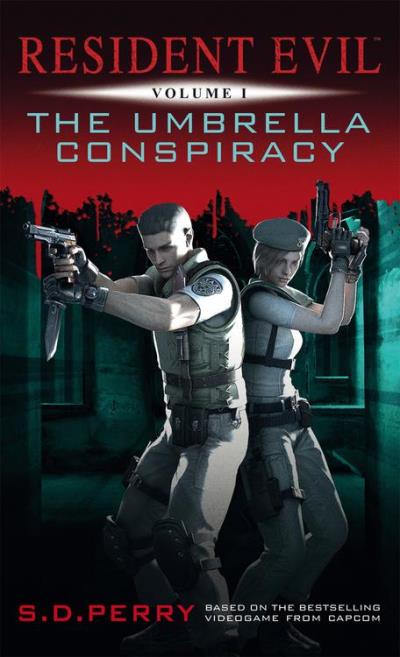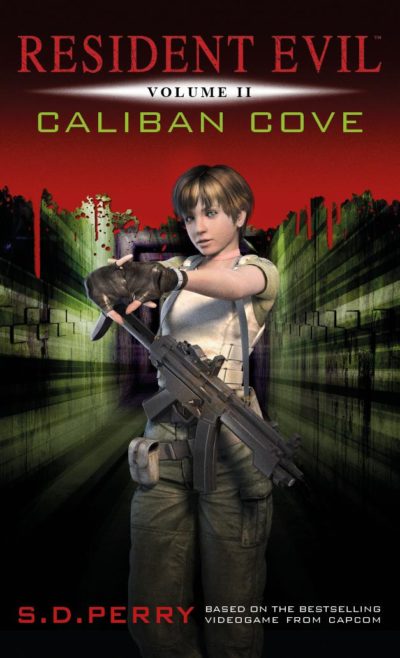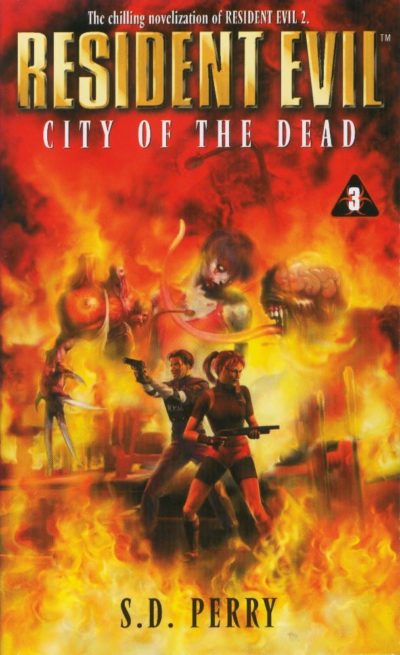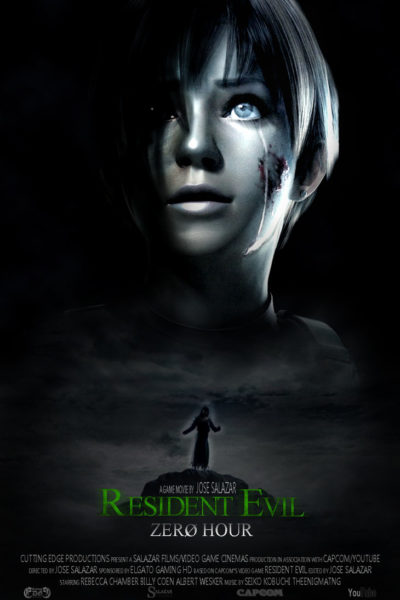I will cheerfully confess to never having played any of the Resident Evil video-games at all. Everything I know about its universe, I learned from the films starring Milla Jovovich. It was thus something of a surprise to learn that her character, Alice, was entirely created for the films, and doesn’t appear in the game series at all. That said, there’s a reason why Paul Anderson opted to make his hero a heroine. The series has been emphatic about being thoroughly equal-opportunity in its carnage since 1996. It was then the first game came out, as Biohazard in Japan, offering players a choice between playing as either Chris Redfield or Jill Valentine.
With the film series coming to an end (supposedly!), it seemed like a good point to dip into the more “authentic” parts of the universe. I don’t have the time or enthusiasm for the games, but figured the novels, written by S.D. Perry, would fit my lifestyle nicely. There are seven of these, with five being novelizations based on the first five games, along with two original stories, which take place between #1 and #2, and #2 and #3 respectively. While they’re not as thoroughly heroine-centric as the movies, they’re no less equal-opportunity than the games, with Valentine leading a swathe of solid and strong female characters.
 |
The Umbrella ConspiracyIn the opening book, we follow members of the S.T.A.R.S. task force, investigating a series of brutal murders on the outskirts of Raccoon City, only to be trapped in a manor house. This turns out to be a research facility for the Umbrella Corporation, abandoned after an accidental release of T-virus and now inhabited by zombies and other unpleasant creatures. These include cannibalistic plants and the “Big Bad”, the Tyrant, the end result of prolonged exposure to the virus. In terms of spirit, this isn’t dissimilar to the first film, which similarly had a group of soldier types exploring a research complex infested with both monsters and traps, albeit a far larger one. The book’s origins as a game are sometimes clunkily obvious here, with traps and puzzles showing up in the prose here, in ways that would only make sense in a Playstation context. It’s also a little heavy on minute details, such as getting very specific on the layout of the house, which really doesn’t deserve as many words. There’s a multi-threaded storyline, focusing on Redfield and Valentine, but also involving the other members of the S.T.A.R.S. team, and this works better than you might expect. Perry keeps all the balls in the air effectively, and things converge nicely on a rather Aliens-esque finale, the team rushing to escape the facility before it self-destructs. Which probably makes sense, as Perry also wrote several entries based on the Dark Horse Comics Aliens series |
 |
Caliban CoveThe second book takes place between the first and second entries in the game series, rather than being an adaptation. Despite this, it feels similar to the first novel, with another S.T.A.R.S. team – this one not officially sanctioned – investigating another Umbrella facility gone awry. In this case, however, it’s not the result of an accident, but deliberate malfeasance. Rogue biochemist, Dr. Nicholas Griffin, has created a virus which turns humans into zombies, and now is preparing to unleash that virus on the world. The main heroine is Rebecca Chambers, the teenage biochemist who is the only significant player here carried forward from Book #1. So, I guess she’s playing the Ripley in Aliens role. The “puzzles” the team need to solve barely register: “As I was going to St. Ives…”? Really? Guess Perry didn’t see Die Hard With A Vengeance. The other weakness is the author’s struggles with the action sequences; while these are fine when it’s one-on-one, the depiction of anything involving more participants becomes hopelessly jumbled and confusing. There are some positive aspects. One perspective provided in the book is that of someone infected by the virus, which is chilling in its depiction of the inexorable loss of control. Some of the monsters are also nicely done, particularly the aquatic Leviathans, whose understated descriptions are quite Lovecraftesque. Otherwise, though, this feels too much like a retread of its predecessor, in both style and content. |
 |
City of the DeadA novelization of the second game, this introduces two major characters. Along with Claire Redfield, who arrives in Raccoon City seeking her brother, the other hero is Leon Kennedy, a newly-assigned cop. Both are understandably disturbed to find it the epicentre of a zombie outbreak, and have to survive those and a bevy of even nastier monstrosities. There’s also Ada Wong, an independent agent, who has been sent in to obtain a sample of the G-virus, the even more twisted successor to the T-virus. This is a relatively straightforward tale, simply and effectively told. That said, the Aliens aspects are almost overwhelming. Monster which crawls down your throat, gestates for a bit and then comes out? Check. [The book even calls it, “A chest-bursting parasitic creature. straight out of a sci-fi movie”…] Heroine who ‘adopts’ a little girl who has been scurrying around, trying to survive and hide from the monsters? Check. Frenzied rush to escape, as the location counts down towards complete immolation? Check. Otherwise, though, it’s not bad at all, even if I could probably also have done without the clunky romantic tension between Kennedy and Wong. I definitely wish they had made this into a movie; Redfield and Wong provide enough action heroine-ness to go around, and the chief human antagonist is also female, Umbrella researcher, Annette Birkin. Perry delivers a solid page-turner, engaging in spectacularly moist prose to describe the creatures now roaming Racoon City. |
 |
UnderworldSadly, not the hoped-for crossover featuring Milla Jovovich and Kate Beckinsale. Instead, it sees a five-person team of former S.T.A.R.S. sent to Utah, where the mysterious Trent tells them a simple retrieval mission awaits. Needless to say, it proves to be anything but, with the team separated. Three members are stranded up top, facing Umbrella security, while two are stuck below, to run a gauntlet through four test areas, stocked with some of Umbrella’s most lethal creations [It’s a little like the simulations in Resident Evil: Retribution, but with different terrain types, rather than different cities] Indeed, this was disappointingly heroine-light: Leon and John Andrews do most of the heavy lifting, as the pair trapped in the underground complex. Rebecca and Claire are both left up top, and the former is wounded while trying to hide from the security team, so is more an encumbrance than an asset to her colleagues. That only leaves Claire; while brave and resourceful, she’s a civilian, with a civilian’s skill-set, and the ass-kicking which results is inevitably limited in its scope. Like Caliban Cove, this is a standalone work rather than an adaptation of a game, though the structure of the test areas certainly has the feel of stages, with the “Fossil” at the end undeniably Boss-level. I did enjoy the “first-monster” perspective section, telling events from Fossil’s point of view; it’s a somewhat chilling angle, since its life is “Eat. Sleep. Repeat.” But overall, this would likely have been significantly improved if there had actually been considerably more Selene. |
 |
NemesisI was surprised to discover in the course of this one, the short time frame over which this all takes place – it’s only about six weeks since the events of the first novel, and we’re already into the fifth installment, based on the third computer game. The central characters here are Jill Valentine, returning from The Umbrella Conspiracy, and new hero, Carlos Olivera, an Umbrella operative who is unaware of the company’s secrets. The latter is dropped into Raccoon City on a supposed rescue mission, really intended to provide data to the corporation, and it’s not long before he’s the sole survivor of his platoon. Meanwhile, Valentine seeks her own way out, having abandoned her humanitarian efforts, but is trailed by the Nemesis, a particularly unstoppable Umbrella creation programmed to hunt and kill S.T.A.R.S. members. The human villain is another Umbrella soldier Nicholai Ginovaef, a psychopath with his own agenda. It’s decent enough, and good to see Valentine again, who kicks ass solidly. Its origins as a game occasionally remain too obvious – the laser cannon sure is convenient! – though at least the puzzle aspects are more restrained. Ginovaef is a nasty piece of work, especially disturbing since much of it is told from his perspective. Something of a shame he doesn’t get the deserved comeuppance, at the hands of Jill, since the game is played largely from her perspective (Olivera being a helpful NPC). Though Perry probably should have skipped the feeble attempt to explain her tube-top and miniskirt costume. “Mobility”? Suuuuuure… |
 |
Code: VeronicaLooked like earlier entries in the series were building toward a raid by the ex-S.T.A.R.S. on Umbrella’s European headquarters. But this entry leaps over it entirely, and the subsequent capture of Claire Redfield, and begins with her locked up on Rockfort Island, a remote corporation outpost in the Southern Hemisphere. The facility descends into chaos after a T-virus outbreak, and she is set free by a sympathetic employee, to fend for herself among the weaponized creatures roaming the isle. They’re overseen by Alfred Ashford, who’d be described by any passing psychiatrist as “batshit crazy”; she teams up with another prisoner, the even younger Steve Burnside. Cue romantic tension… You sense even Perry is becoming jaded by the repetitive nature of the source material. Early on, Claire quips to herself, “What’s a biohazardous disaster without a crazy or two?”, and later, Steve wonders, “Keys and emblems and proofs and submarines; it was a wonder [Umbrella employees] ever got shit done.” However, Redfield’s return is as welcome as Valentine’s was – pity the game makers never saw fit to team them up. And if the nature of Alfred’s insanity will come as absolutely no shock to anyone who has seen Psycho, the story here then layers an additional level of horror on top, rescuing it from the over-obvious. It felt like the novel is going to end at the 3/4 point, but the plot suddenly diverts to Antarctica for a final section. Claire’s brother, Chris, shows up at Rockfort in search of her, then ends up near the South Pole as well, where we get the grand finale, which seems tacked on. Again, hard to blame Perry for this, and likely not her fault either that, despite being the last novel chronologically, it offers very little in the way of a true conclusion. |
 |
Zero HourHang on, didn’t you say Code Veronica was the last novel? Ah, important word there: “chronologically”. For Perry finished off the series with another novel, which comes at the beginning; it covers the first S.T.A.R.S team to come into contact with the results of the T-virus, whose ‘chopper goes does in the woods near Raccoon City. In particular, it’s the story of Rebecca Chambers, then on her first mission. She comes across a train which has been attacked by persons or creatures unknown, and also Billy Coen, a prisoner and former soldier who escaped while being taken to an impending execution. On balance, I should probably have read this one in its position at the beginning. If there’s not much lost, I was aware Rebecca survived to appear in the subsequent entries, and Coen is nowhere to be found, so there wasn’t much tension here. However, the small cast – there is hardly anyone else present – does mean Perry has the chance to give the characters more depth than some entries in the series. The Coen/Chambers pairing is a good one too, matching up brawn and brains respectively, and I didn’t even mind the inevitable unresolved sexual tension too much. What I particularly liked was the sense of vulnerability that we get from Chambers. She isn’t an unstoppable ass-kicking machine – frankly, after the preceding novels have left the score S.T.A.R.S 6, Umbrella 0, that’s a refreshing breath of fresh air. It left me wishing I’d seen more of her in the series. |
All told, even as someone who has never so much as picked up one of the games, I generally found the novels entertaining. They’re a fast, easy read: my main criticism would be they’re too loyal to the puzzle-solving aspects. These may be an intrinsic part of the game experience, but fail to transfer at all well on to the printed page. But the books do offer a potential route forward for the film franchise, if they decide to continue with it, on past the “final chapter”.
Perhaps the main criticism from existing fans is the way they diverted from the games, but these novels do show, a more faithful adaptation can work as entertainment. There would still need to be some adjustments – tone down the puzzle solving and probably find out a way to limit the need for multiple perspectives too. But there’s little doubt that the characters, situations and monsters offer plenty of cinematic scope, and CGI has improved enough since the original movie in 2002, it is now capable of doing the creatures justice. If Sony opt to reboot, they could go back to Zero Hour, introducing Rebecca, then move into The Umbrella Conspiracy for the rest of the S.T.A.R.S. team. It would be a seam of fresh material, and one potentially also embraced by those “long-suffering” game fans.




